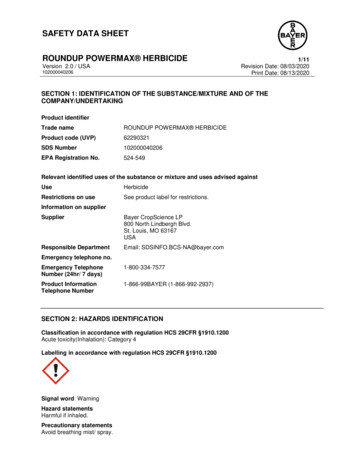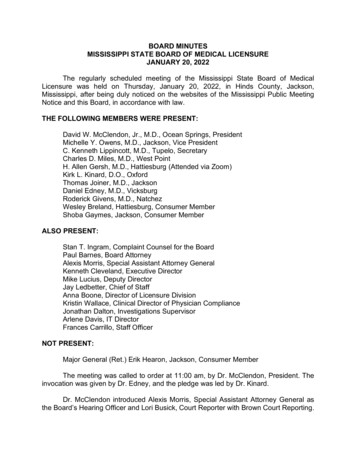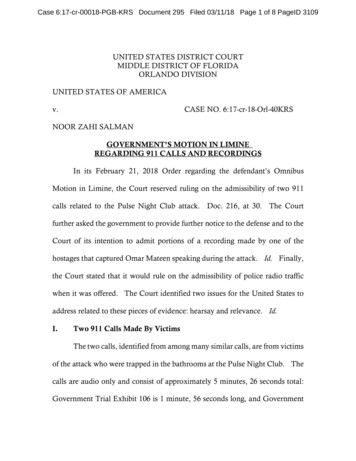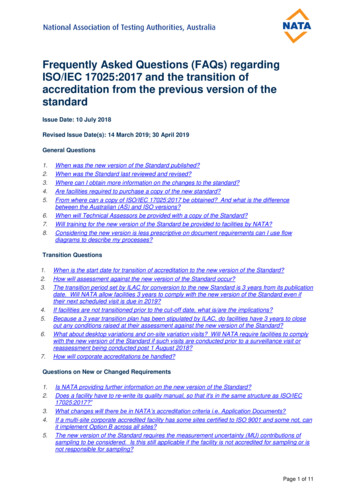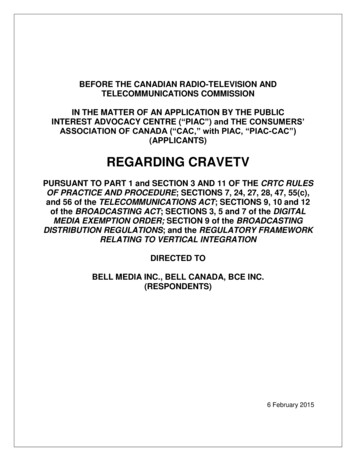
Transcription
BEFORE THE CANADIAN RADIO-TELEVISION ANDTELECOMMUNICATIONS COMMISSIONIN THE MATTER OF AN APPLICATION BY THE PUBLICINTEREST ADVOCACY CENTRE (“PIAC”) and THE CONSUMERS’ASSOCIATION OF CANADA (“CAC,” with PIAC, “PIAC-CAC”)(APPLICANTS)REGARDING CRAVETVPURSUANT TO PART 1 and SECTION 3 AND 11 OF THE CRTC RULESOF PRACTICE AND PROCEDURE; SECTIONS 7, 24, 27, 28, 47, 55(c),and 56 of the TELECOMMUNICATIONS ACT; SECTIONS 9, 10 and 12of the BROADCASTING ACT; SECTIONS 3, 5 and 7 of the DIGITALMEDIA EXEMPTION ORDER; SECTION 9 of the BROADCASTINGDISTRIBUTION REGULATIONS; and the REGULATORY FRAMEWORKRELATING TO VERTICAL INTEGRATIONDIRECTED TOBELL MEDIA INC., BELL CANADA, BCE INC.(RESPONDENTS)6 February 2015
TABLE OF CONTENTS1. NATURE OF APPLICATION . 12. ALLEGED FACTS . 2(a) CraveTV. 2(b) IPTV bundled, inextricably, with Internet Service . 5(c) VI Entities versus Netflix . 53. ISSUES AND GROUNDS OF APPLICATION . 7Issue 1. What is CraveTV? . 8Issue 2. What rules apply to CraveTV? . 8Broadcasting Act. 9VI Framework .10Digital Media Exemption Order .11CraveTV accessed via IS as a DMBU .12DMEO prohibition against undue preference .12Anti-competitive “head start” rule .13Exclusivity .14CraveTV accessed via IS as something other than a DMBU .14Telecommunications Act .15Issue 3. On what technical and regulatory basis is it appropriate for CraveTV, whenaccessed via a set-top box, to be treated differently for billing purposes than when CraveTVis accessed via a wireless or Internet connection? .16Issue 4. On what technical and regulatory basis is there for Bell to offer CraveTV exclusivelyto BDU customers? .17Issue 5. Is CraveTV being marketed and provisioned in a manner that circumvents rules inplace to promote competition and consumer choice and to mitigate against the harmfuleffects of vertical integration? .18Issue 6. Is tying the sale of CraveTV to a BDU subscription consistent with the broadcastingpolicy objectives? .20Issue 7. If the structuring, marketing and provisioning of CraveTV are technically compliantwith current Commission frameworks, should the Commission undertake reform?.244. LEIACOMM, TALK TV, AND THE DUTY TO CONSIDER . 25The Commission’s Decision .25Commissioner Shoan’s Dissent .26PIAC’s Request to Adjourn Leiacomm: Core issues about streaming need to be explored .26The Commission’s Duty to Consider.275. NATURE OF DECISION SOUGHT . 28Alternative relief.296. COMMISSION’S JURISDICTION . 29
Part 1 Application by PIAC-CACCraveTV tied selling6 February 20151. NATURE OF APPLICATION1)The Public Interest Advocacy Centre (“PIAC” 1 ) and the Consumers’ Association ofCanada (“CAC,”2 collectively “PIAC-CAC”) file this Application with the Canadian Radiotelevision Telecommunications Commission (the “Commission” or the “CRTC”) underSections 7, 24, 27, 47, 55(c), and 56 of the Telecommunications Act,3 Section 9(4) of theBroadcasting Act, 4 Sections 3, 5 and 7 of the Digital Media Exemption Order (the“DMEO”), 5 and the Regulatory framework relating to vertical integration (the “VIFramework”), 6 as well Part 1 and sections 3 of the CRTC Rules of Practice andProcedure7, regarding the “CraveTV” service offered by Bell Media Inc. (“Bell” or “BellMedia”) and distributed through several broadcasting distribution undertakings (“BDUs”).2)Bell Media, and its telecommunications affiliate Bell Canada, are each owned by BCE Inc.3)For the reasons which follow, PIAC-CAC contend that Bell is offering the CraveTV servicein a manner which unduly prefers Bell and other BDU distribution services, and unjustlydiscriminates against standalone competitive providers of internet service (“IS” and“ISPs”) and in a manner designed to circumvent rules in place to promote competition andconsumer choice and to mitigate against the harmful effects of vertical integration.4)PIAC-CAC contend that while CraveTV may appear, when accessed via IS, to be anexempt Digital Media Broadcasting Undertaking (“DMBU”) under the DMEO, the linkbetween CraveTV access and a BDU subscription renders CraveTV an extension of thelicensed system, in which case, CraveTV requires a license and should be held to therelevant conditions of licence and contribution requirements.5)PIAC-CAC further contend that the tied sale of online streaming services to a BDU serviceis contrary to the Canadian broadcasting policy objectives, and to sanction that tied sellingwould also be contrary to the Canadian broadcasting policy objectives.1234567PIAC is a non-profit organization that provides legal and research services on behalf of consumerinterests, and, in particular, vulnerable consumer interests, concerning the provision of importantpublic services. See Public Interest Advocacy Centre, online: http://www.piac.ca .CAC is an independent, non-profit, volunteer-based charitable organization with a mandate toinform and educate consumers on marketplace issues, to advocate for consumers withgovernment and industry, and work with government and industry to solve marketplace problems.See Consumers' Association of Canada, online: http://www.consumer.ca/index.php4 .S.C. 1993, c. 38.S.C. 1991, c. 11.Broadcasting Order CRTC 2012-409 - Amendments to the Exemption order for new mediabroadcasting undertakings (now known as the Exemption order for digital media broadcastingundertakings) (26 July 2012).Broadcasting Regulatory Policy CRTC 2011-601 - Regulatory Framework for Vertical Integration(21 September 2011).SOR/2010-277.1 of 30
Part 1 Application by PIAC-CACCraveTV tied selling6 February 20156)PIAC-CAC contend that to sanction the tied selling of CraveTV and BDU services wouldbe anti-competitive, anti-consumer, and inconsistent with the broadcasting policyobjectives.7)PIAC-CAC therefore request that the Commission require Bell to apply for a licence forthe CraveTV service. Alternatively, if the Commission determines that CraveTV is anexempt DMBU under the DMEO, then the Commission should confirm that tied selling ofonline streaming services with BDU services is a violation of the exclusivity rules, or in thealternative undertake expanding the DMEO’s exclusivity provision to include BDUdistribution.2. ALLEGED FACTS8)In this Section PIAC-CAC outlines the alleged facts on which this Application is based.Specifically, PIAC-CAC describe the relevant terms and conditions of the CraveTVservice, and the way the programs are marketed and billed to customers.(a) CraveTV9)8Beginning as early as Bell’s first attempt to purchase Astral, Bell has been telling theCommission that it intended to launch a protective response to Netflix.8Transcript of Proceeding, Volume 1, 10 September 2012 - To consider the broadcastingapplications listed in Broadcasting Notice of Consultation CRTC 2012-370 and 2012-370-1(emphasis added):164 [MR. BIBIC]:I think that will be one of the most interesting evolutions over the next fiveyears; how that plays out. We think today's transaction puts the Canadian broadcastsystem in a much stronger position in terms of making sure Canadians have an OTTservice that a Canadian broadcaster could bring to the market. And what is reallyimportant about that is we see the equal system is distributing that through thecurrent BDU's.602 MR. BIBIC: I don't think I was hedging my bets. We didn't come before you today inthe context of this transaction to say, look, there's this threat from over-the-topproviders, global competitors who are acquiring content and competing in Canada,for the purpose of saying, therefore, you must impose regulatory rules on them and oneveryone else; that is not what our position is here today. In fact, our position is that is aninescapable fact. Our viewership is significant to those services; as we say in ouropening statement: 11 million hours a week of viewing to these services, and then stats toback that up are in the monitoring reports. What we are saying is it is inevitable; theconsumers love this type of content; they love the flexibility. So what are we going todo? We are going to step forward and we are going to compete; and we are going togive Canadian consumers back to - Mr. Chairman - to the point about the consumer andreading the letters from the consumers is very important. We will compete and offer amade-in-Canada service, national, bilingual - French and English - available through thedistributor of their choice.2 of 30
Part 1 Application by PIAC-CACCraveTV tied selling6 February 201510)On 30 October 2014 Bell announced it would soon launch an “on-demand subscriptionservice,” “designed to enhance the value of the subscription television ecosystem,”“available to every TV provider in Canada.”911)Originally code-named “Project Latte,” the service would launch on 3 December 2014 as“CraveTV.”1012)Described at launch by Bell as “Canada’s premium subscription on-demand videostreaming service,” priced at 4 per month, Bell stated that it had, or would soon,conclude “distribution partnerships” with TELUS Optik TV, Bell Fibe TV, Bell AliantFibreOP TV, and Bell Satellite TV, Eastlink, Northwestel and other Canadian CableSystems Alliance (CCSA) members. In the CraveTV FAQs, Bell states that Bell is “in talkswith all television service providers to get it in your hands.”1113)PIAC-CAC are unable to confirm if CraveTV will be available to all BDUs in Canada, oronly those selected by Bell, and furthermore, when CraveTV will be made available tothose BDUs, and whether Bell is negotiating commercially reasonable terms. PIAC-CACcannot ascertain if Bell intends to make CraveTV available to all BDUs, or only certainones who meet criteria defined by Bell. PIAC-CAC are also unable to ascertain if Bell isgaining any competitive advantage due to unreasonable commercial behaviour in themaking available of CraveTV to other BDUs.14)In order to have online access to CraveTV, Bell customers must purchase BDU servicefrom a BDU with whom Bell has concluded a distribution agreement. The current eligibilityrequirements for accessing CraveTV are provided in Figure 1.91011Bell press release, “Bell Media to Launch New Streaming Service Devoted Exclusively toExceptional TV” (30 October 2014), online: ceptional-tv/ .Bell press release, “Introducing CraveTV(TM): All You Can Watch for 4/Month” (3 December2014), online: ceptional-tv/ .CraveTV Help/FAQs, “I really want to subscribe, but I don't see my television provider listed.What gives?” (Accessed 4 February 2015) online: http://help.cravetv.ca/ .3 of 30
Part 1 Application by PIAC-CACCraveTV tied selling6 February 2015Figure 1. Minimum Sign-up Requirements for CraveTV12BDUPrerequisite ServicesEntry-level Pricing Bell TV (satellite) Does not have Crave on13demand channel 48.95/month 4/month Crave 52.95/month Bell Fibe TV Fibe Internet 108/month 4/month Crave 112/monthBell AliantNorthernTel Bell (Aliant) FibreOP TV Need not includeInternet 56.95/month 4/month Crave 60.95/monthTELUS TELUS Optik TV Essentials package 34/month 4/month Crave 38/month Eastlink “video service” No pricing info on websitefor single service Estimated cost:15 78.85 4/month Crave 82.85/monthBellEastlink12131415Available Platforms TV – set top box ondemand channel Laptop, desktop –CraveTV website Mobile device –CraveTV iOS/AndroidApp Coming soon Samsung SmartTV app Xbox 360/One app Windows Phoneapp Windows 8 app Chromecastsupport Roku support AppleTV app14(maybe)Notes:- Prices are not including any promotional discounts.- Does not appear possible to get CraveTV with only TELUS Satellite TV service- Does not appear possible for Eastlink subscribers to get CraveTV via set-top box;website/apps only (see online: ne and Eastlink’s twitter customer support notes they are working on it, online: 4291 )- Eastlink does not have any promotional material related to CraveTV on their websiteA press release says Bell is going to offer CraveTV on select set-top boxes in early 2015 (likelynewer boxes not yet released): Bell Canada, “CraveTV available now for Bell Fibe TV and BellAliant FibreOP TV subscribers” (11 December 2014), online: eop-tv-subscribers .Michael Oliveira, “Bell Media says Apple not allowing Crave app for Apple TV” (21 January 2015),online: http://www.theprovince.com/Bell Media says Apple allowing Crave Apple/10748169/story.html .Eastlink’s website does not provide the cost of a BDU subscription, but provides pricing for 3bundles: TV Internet ( 138.80), TV landline ( 114.85) and Internet landline ( 95.95). Assumingthe bundle discount is the same for each, solving for the cost of TV: (138.80 114.85 - 95.95)/2 78.85 bundle discount.4 of 30
Part 1 Application by PIAC-CACCraveTV tied selling6 February 2015(b) IPTV bundled, inextricably, with Internet Service15)In at least one case, the case of Bell provisioning CraveTV to Bell subscribers, it appearsthe provisioning of TV service (Fibe TV) is linked to the provisioning of internet service(Fibe Internet): with FibeTV comes, automatically, Fibe Internet, not as a bundle, but as aco-requisite service – the consumer has no choice but to take the Bell IS with the BellBDU service. (see Figure 2).Figure 2. Bell Fibe TV includes Fibe Internet1616)It is not clear, based on PIAC-CAC’s research in Figure 1 above, whether other BDUs’ TVofferings are co-requisite with IS, and PIAC-CAC invites the Commission to determinethose facts.(c) VI Entities versus Netflix17)16Bell is not the only vertically integrated (“VI”) entity to launch an online streaming servicetied to a specific distribution service or distribution technology. Rogers and Shaw, as ajoint venture, and Vidéotron have each launched online streaming services. The RogersShaw online streaming service, Shomi, is the subject of a Part I application filedconcurrently with this application. PIAC-CAC understand that access to Vidéotron’sOnline: http://www.bell.ca/Fibe-TV .5 of 30
Part 1 Application by PIAC-CACCraveTV tied selling6 February 2015streaming service, Illico (formerly known as Club Illico Unlimited) is available withouthaving to subscribe to any affiliated internet service or BDU service.1718)A table comparing the VI entities’ online streaming services to Netflix is provided below.Figure 3. VI Entities’ Online Streaming Services versus NetflixServiceMonthlyPriceNetflix 8.99Anyone with Internet connectionMore content, newermovies 8.99Rogers and Shaw Internet or TVcustomersEmphasis on userinterface and video-storeclerk-like curation ofcontentShomi(Rogers)Shomi(Shaw)CraveTV(Bell) 4.00(additionalpackages upto 15)Currently Available ToTV customers of Bell or Bell Aliant,TELUS, Eastlink(Bell FibeTV also requires FibeInternet)CompetitiveDifferentiationEmphasis on TV (lessabout movies, no kidsTV)Bell Satellite TV customersAnyone with Internet connectionClub Illico(Vidéotron)17 9.99STB access reserved for Vidéotronsubscribers with a “new generation”STBFrench contentAccording to Vidéotron’s FAQs, online: n/faqclub-illico :A PIAC representative telephoned Vidéotron customer service on 21 January 2013 andconfirmed that once a person signs up for Club Illico, they receive an account number which theycan then use online at illico.tv or on the Android/iPad apps to access the content. There is noneed to have a TV subscription or a Vidéotron internet service in order to access content viaillico.tv or the mobile device apps.6 of 30
Part 1 Application by PIAC-CACCraveTV tied selling6 February 201519)PIAC-CAC contend, for reasons explained in the following section, that Bell is engaged inanti-competitive tied selling by tying CraveTV access to subscription to a BDU service.20)While PIAC-CAC believe that this exclusivity is prohibited by the DMEO, if it is not, PIACCAC contend it should be, and therefore PIAC-CAC request that the Commissionundertake amending the DMEO to explicitly address tied-BDU selling.21)PIAC-CAC also contend that when the tied BDU service is inextricably linked to anaffiliated IS (as it is in the case of Bell’s FibeTV which includes Fibe Internet), then Bell inits telecommunications capacity is also violating the Telecommunications Act prohibitionagainst undue preferences and unjust discrimination.22)PIAC-CAC further content that even where CraveTV is offered by a BDU that does notrequire include IS with its BDU service, by favouring the BDU access system as a whole,this harms competition, the business case of independent ISPs, and consumers who wishto fine-tune their viewing experience and the access platform of their choosing, andreduce their monthly communications expenses. The requirement to purchase one form ofbroadcasting access, in the face of increasing consumer demand for alternative, ondemand access via different modes of access, is detrimental to consumer choice andcompetition, and contrary to the broadcasting policy for Canada.3. ISSUES AND GROUNDS OF APPLICATION23)In the view of PIAC-CAC, the marketing and provisioning of CraveTV raise a number ofregulatory issues:Issue 1. What is CraveTV?Issue 2. What rules apply to CraveTV?Issue 3. On what technical and regulatory basis is it appropriate for CraveTV, whenaccessed via a set-top box, to be treated differently for billing purposes thanwhen CraveTV is accessed via a wireless or internet connection?Issue 4. On what technical and regulatory basis is there for Bell to offer their CraveTVexclusively to BDU customers?Issue 5. Is CraveTV being structured, marketed and provisioned in a manner thatcircumvents rules in place to promote competition and consumer choice and tomitigate against the harmful effects of vertical integration?Issue 6. Is tying the sale of CraveTV to a BDU subscription consistent with thebroadcasting policy objectives?7 of 30
Part 1 Application by PIAC-CACCraveTV tied selling6 February 2015Issue 7. If the structuring, marketing and provisioning of CraveTV is technically compliantwith current Commission frameworks, should the Commission undertakereform?24)It is PIAC-CAC’s contention that CraveTV is an online streaming service that is tied to theconsumption of BDU services (and in Bell’s case, also IS), invoking several differentregulatory frameworks.25)It is PIAC-CAC’s further contention that the regulatory frameworks invoked by CraveTVcontain prohibitions on undue preferences and tied selling, and that Bell is in violation ofthose rules.26)It is PIAC-CAC’s contention that there is no technical or regulatory basis for Bell to betreating BDU-access to CraveTV differently than ISP-access to CraveTV content.Furthermore, there is no technical or regulatory basis for Bell to be restricting access toCraveTV content on the basis of a subscription to a BDU service.27)Ultimately, it is PIAC-CAC's contention that Bell (like Rogers, Shaw and Shomi) isstructuring its online streaming service in a manner designed to circumvent rules meant topromote competition and consumer choice and to mitigate against the harmful effects ofvertical integration.28)PIAC-CAC address each of these issues below.Issue 1. What is CraveTV?29)It is PIAC’s contention that CraveTV is a subscription-based online streaming servicetied to a class of BDU services. Furthermore, at least one BDU service (Bell’s) isinextricably tied to IS. Accordingly, a range of regulatory requirements attach to thestructuring, marketing and provisioning of the CraveTV service, as discussed in the nextsection.Issue 2. What rules apply to CraveTV?30)The second issue, related to the first one, is What rules apply to CraveTV? It is thecontention of PIAC-CAC that Bell’s provisioning of CraveTV invokes several differentregulatory frameworks.31)Because Bell’s Fibe IS, a telecommunications service, is co-requisite with Bell’s Fibe TV,the Telecommunications Act is engaged. In particular, the prohibition against undue8 of 30
Part 1 Application by PIAC-CACCraveTV tied selling6 February 2015preference and unjust discrimination applies, having not been forborne by theCommission.32)As PIAC-CAC and COSCO argued in the Mobile TV undue preference proceeding(leading to Broadcasting and Telecom Decision CRTC 2015-26)18, a broadcasting affiliateof a converged and vertically-integrated entity’s telecommunications affiliate cannot claimcover under the Broadcasting Act as a way to violate the Telecommunications Act. Nomatter which direction these entities turn, they face the doctrinal prohibition against unduepreference and unjust discrimination that has been given legal effect in theTelecommunications Act, the DMEO and VI Framework.Broadcasting Act33)Bell owns and operates both “programming undertakings” and “distribution undertakings”and is therefore governed by the Broadcasting Act, regulations and rules madethereunder.34)The Broadcasting Distribution Regulations 19 “apply to persons licensed to carry on adistribution undertaking.” Section 3 of the BDU Regulations states that “A licensee shallnot distribute programming services except as required or authorized under its licence orthese Regulations.” Section 9 contains a prohibition against undue preference ordisadvantage. 2035)CraveTV, as a programming service accessed via STB, is also bound by rules for VODservices. PIAC-CAC believe that CraveTV, when accessed via STB, will be provisioned asa VOD service, though PIAC-CAC have not seen any Bell application for such a licence,or an application for an extension. If CraveTV obtains the appropriate VOD authorization,then STB CraveTV (as distinguished from IS CraveTV) will be bound by conditions of181920Broadcasting and Telecom Decision CRTC 2015-26 - Complaint against Bell Mobility Inc. andQuebecor Media Inc., Videotron Ltd. and Videotron G.P. alleging undue and unreasonablepreference and disadvantage in regard to the billing practices for their mobile TV services BellMobile TV and illico.tv (29 January 2015) [Mobile TV].SOR/97-555.Broadcasting Distribution Regulations, SOR/97-555, s. 9:9. (1) No licensee shall give an undue preference to any person, including itself, or subjectany person to an undue disadvantage.(2) In any proceedings before the Commission, the burden of establishing that anypreference or disadvantage is not undue is on the licensee that gives the preference orsubjects the person to the disadvantage.9 of 30
Part 1 Application by PIAC-CACCraveTV tied selling6 February 2015licence, and subject to certain expectations and encouragements. 21 Section 10 of theVOD COLs include a prohibition against undue preference or disadvantage.22VI Framework36)Bell Media is an affiliate within a “vertically integrated” entity23 (owning both programmingand distribution assets), and thus subject to the VI Framework promulgated under theBroadcasting Act.37)In the VI Framework decision, the Commission expressed concerns about consumer harmand reduced competition were VI entities able to exercise exclusivity on new media (i.e.,online) over programming designed primarily for services including VOD services(emphasis added):21.In light of the above, the Commission considers that permitting VIentities to exercise exclusivity with respect to the distribution on new mediaplatforms of programming designed primarily for conventional television,specialty, pay and VOD services would result in harm to consumers and thecompetitiveness of the industry. The Commission further considers that thesame harm would result if industry players that are not VI entities exercisedsuch exclusivity.22.Accordingly, the Commission has decided that no person operatingunder the Exemption order for new media broadcasting undertakings (NewMedia Exemption Order) may offer programming designed primarily forconventional television, specialty, pay or VOD services on an exclusive orotherwise preferential basis in a manner that is dependent on the subscriptionto a specific mobile or retail Internet access service. Rights for suchprogramming shall be acquired on terms that allow them to be made availableto competitors as part of a licensing agreement, or other such arrangements,thereby ensuring the availability of the programming to consumers of competingdistributors on fair and reasonable terms. The Commission considers that thisapproach will ensure that the most popular programming is available toconsumers subject to normal commercial terms and that consumers will be ableto receive their preferred programming from a variety of distributors.2122Appendix to Broadcasting Regulatory Policy CRTC 2011-59 - Standard conditions of licence,expectations and encouragement for VOD undertakings.Appendix to Broadcasting Regulatory Policy CRTC 2011-59 - Standard conditions of licence,expectations and encouragement for VOD undertakings, S. 10:10. The licensee shall not give an undue preference to any person, including itself, orsubject any person to An undue disadvantage. In any proceedings before theCommission, the burden of establishing that any preference or disadvantage is not undueis on the licensee that has given the preference or subjected the person to thedisadvantage.23BCE Inc. owns Bell Canada which owns Bell Canada and Bell Media Inc. BCE Ownership Chart,online: http://www.crtc.gc.ca/ownership/eng/cht143.pdf .10 of 30
Part 1 Application by PIAC-CACCraveTV tied selling6 February 201523.However, to encourage innovation in programming, the Commissionfinds that exclusivity may be offered for programs that are created specificallyfor new media platforms.38)The Commission recently repeated these concerns in the Mobile TV decision.2439)In PIAC-CAC’s view, it would be artificial and disconnected from the converged andvertically integrated nature of Bell (and more broadly, the communications market inCanada) to find, based on inappropriately literal interpretations of the relevant rules, that itis acceptable to tie access to an online streaming service to a specific mode of access(BDU service in this case) only to protect the entity’s licensed businesses.Digital Media Exemption Order40)CraveTV, when consumed via IS (as an online streaming service), may be characterizedto some extent as a “digital media broadcasting undertaking” (“DMBU”) under the DMEO.41)A DMBU is defined in the DMEO as an undertaking that provides broadcasting services,in accordance with the interpretation of “broadcasting” set out in New Media, BroadcastingPublic Notice CRTC 1999-84/Telecom Public Notice CRTC 99-14, 17 May 1999, that is:a) delivered and accessed over the Internet; or b) delivered using point-to-pointtechnology and received by way of mobile devices.24Mobile TV at paras. 55, 58-59:55. The Commission acknowledges that no complaints or interventions were filed bycompeting service providers. It nevertheless considers that Bell Mobility’s and Videotron’sarguments are not persuasive: not only do they fail to address the impact of the significantdifference in data charges on consumers, they also do not address the potential forsignificant harm in the future to other audiovisual content services accessible onsubscribers’ mobile devices that are subject to data caps. Given the considerabledifference in the data charges in question, t
conclude "distribution partnerships" with TELUS Optik TV, Bell Fibe TV, Bell Aliant FibreOP TV, and Bell Satellite TV, Eastlink, Northwestel and other Canadian Cable Systems Alliance (CCSA) members. In the CraveTV FAQs, Bell states that Bell is "in talks with all television service providers to get it in your hands."11
